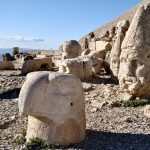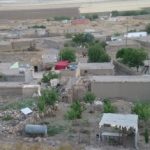Home to the beehive houses Population: 7,800
Old name: Carrhae (Roman), Hellenopolis (Byzantine)
Of Turkey’s many iconic sites, one of the most remote is Harran (Altınbaşak), the dusty desert settlement due south of Şanlıurfa that is famous for its beehive houses (kümbet/kubbeli evleri). You’ll find them dotted all over the settlement in groups of six to eight. They remind me of kilns just waiting for the potters to come along with their wares.
Apparently the houses were originally designed with their familiar conical stone roofs because of the shortage of wood with which to make more conventional flat versions. Given that there was plenty of stone nearby the solution was obvious, and the beehive-house design is thought to have been in existence since as long ago as 300 BC.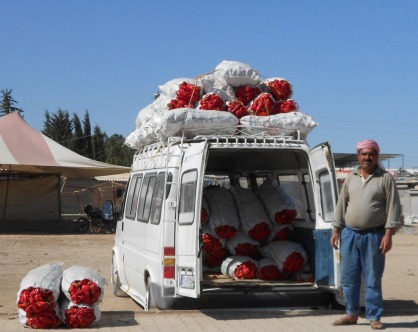
The versions you’ll see dotted about town today though are mostly no more than 200 years old at most. The majority now stable animals or are used as storerooms by owners who prefer to live in modern concrete houses like everybody else, although a few have been spruced up as cafes-cum-accommodation for tourists.
Harran lies in a part of the country whose economy has been transformed by the possibility of cultivating cotton brought about by the GAP Project (Güney-batı Anadolu Projesi, South-east Anatolian Project).
Depending on the time of year you may see locals – an estimated 40% of them Arabs – harvesting lentils, corn or cotton in the surrounding fields, such labour having put paid to erstwhile grinding poverty. Not surprisingly, while the houses may look simple from the outside, on the inside they often contain just as many consumer durables as homes in Urfa itself.
Harran’s beehive houses are the only such structures still standing in Turkey, even though other nearby villages probably once featured them as well (there are a few very ruinous examples on the outskirts of Suruç, for example). If you cross over the border to Syria, however, there are (were?) many villages around Aleppo (Halep) that are similarly endowed, proof, as ever, that culture recognises no political boundaries.
Unfortunately Harran has a bad reputation for hassle. You will barely have got out of your car or bus before children will be swarming round you pestering you to buy things or accept them as “guides”. Some people find this endearing, others irritating. For the sake of the latter please DON’T give out sweets, pens or money as it only exacerbates the situation.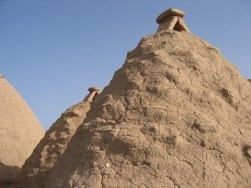
Harran is a rare town whose existence can be recognised from references in the Biblical book of Genesis; the Prophet İbrahim (Abraham), who is believed to have been born in Urfa, is thought to have stayed here while travelling between Ur (in modern-day Iraq) and Palestine.
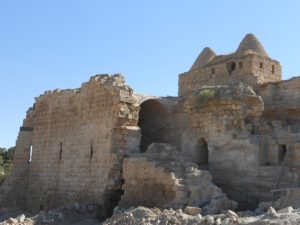
Not surprisingly, then, there are traces here of buildings that long pre-date the beehive houses and there is believed to have been an important Assyrian settlement here with, at its heart, a temple to the moon god Sin that probably dated back to before 2000 BC. There are no obvious remains of the temple which probably stood where the castle is now and was destroyed on the orders of Emperor Theodosius in 382 but if you travel on from Harran to Soğmater you will see clear evidence of the moon cult in and around the modern village there. The cult proved surprisingly tenacious, continuing, it is thought, until 1081 when it was suppressed by the local governor Yahya bin El-Şatr.
Given the proximity of what was Edessa and is now Urfa it’s not perhaps surprising that the Romans had their day in the sun here too, with a colourful story relating how, in 53 BC, a Roman general called Marcus Licinius Crassus, one of the wealthiest men ever to have lived, was stopped in his tracks by Parthian warriors who crucified him and poured molten gold into his mouth to show their contempt for his cash.
Regardless, the Romans kept on coming and established Harran as a centre of learning, a role it held onto into the Byzantine period and that became even more important after the Arabs seized the town and established the first Islamic university here.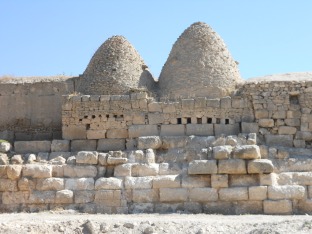 Beehive houses against as yet unrestored section of city wall
Beehive houses against as yet unrestored section of city wall
In 1104 the Battle of Harran pitched the Crusader forces under Baldwin II of Edessa, Bohemund I of Antioch and Tancred of Galilee against the Selçuk forces led by Çikirmiş of Mosul and Sokman of Mardin. The Crusaders were decisively defeated. Some sources suggest that the battle actually took place closer to ar-Raqqah which is now in Syria.
Around town
If you get out of the dolmuş as it passes the Bazda Motel you will see the old city walls right in front of you. The main settlement of Harran was ringed by once crumbling stone walls which originally boasted an almost unbelievable 187 towers and four gates. On my most recent visit (June 2015) these walls had been very crudely restored (encased in new stones) although a pleasant promenade with sitting areas had been laid out to encourage people to sit and study them. Sadly, these kiosks had become makeshift homes to some of the many Syrian refugees.
If you walk through the ruined gate ahead of you, the Halep (Aleppo) Kapısı, you should be able to make out the tall minaret (more than 33 metres high) of the Ulu Cami attached to the original Harran University ahead and to the left. The Ulu Cami was commissioned by the Umayyad caliph Marwan II in the mid-8th century and the ruins of the university stand right beside it. A wire fence has prevented visitors approaching the ruins for many years.
On the mound behind the ruins of the university there are more excavated remains, again fenced off.
From the Ulu Cami you will be able to see the first of the beehive houses a short walk away across ground littered with what must be the remains of the earlier settlements here.
Buried amid the beehive houses is a large honey-coloured castle whose walls are adorned with carvings including a fine one of a lion marking the eponymous Aslan Kapısı (Lion Gate). It is believed to have been built over the site of an ancient Sabian temple. There may have been some sort of fortification here since Hittite times but the current castle appears to be a mainly Fatimid construction of 1059 intended to ward off the Crusaders who later managed to seize it for themselves anyway. The media reported that parts of the castle would open to the public in 2019 although I have not been back to see for myself.
To find out more about the beehive houses duck into the Harran Kültür Evi near what was once the Mosul Kapısı. It features a pleasant walled courtyard backed by a line of beehive structures, some of them decked out with the sort of furnishings typical of local houses, others selling souvenirs, including wall hangings (üzerlik aynası) made out of the dried seeds of a local plant which are said to be good for warding off the evil eye.
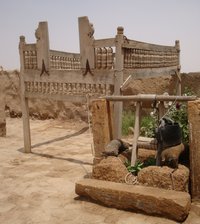 Sleeping
Sleeping
Although Harran does have one conventional hotel in the modern settlement of Altınbaşak just outside the old walls, it’s more fun to put up at the Kültür Evi (or one of its two competitors) where you can sleep on mattresses on the floor or out in the courtyard under the stars where there are two raised wooden tahts (thrones), their beautifully carved balustrades a poignant reminder of what used to be before most locals abandoned wood in favour of blue-painted metal thrones.
Bazda Motel. Tel: 0414-441 3590
Harran Kültür Evi. Tel: 0414-441 2477
Transport info
There are regular dolmuşes to Harran from Urfa. They leave from the otogar although you can also pick them up from a stop on the main road in front of the Mahmudoğlu Kulesi in the Beykapısı neighbourhood, east of Gölbaşı.
Local tour companies compete to offer trips to Harran and are likely to deny the existence of the dolmuşes. A few used to offer onward excursions to Soğmater and the other desert attractions although the downturn in tourism means that these may no longer be available unless you’re in a large group.
Day trip destinations


